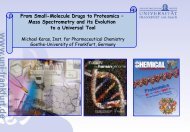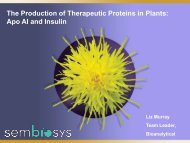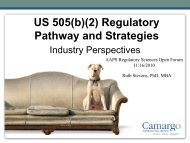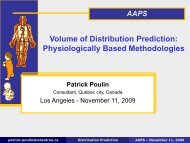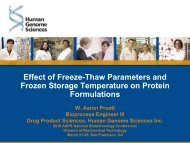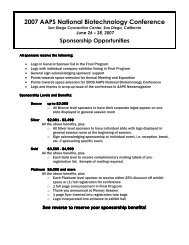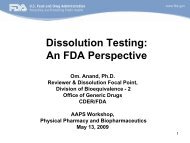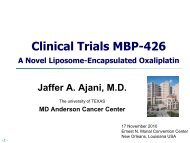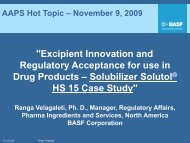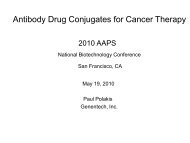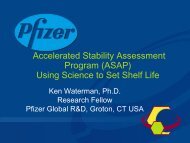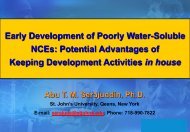Preliminary Program - American Association of Pharmaceutical ...
Preliminary Program - American Association of Pharmaceutical ...
Preliminary Program - American Association of Pharmaceutical ...
Create successful ePaper yourself
Turn your PDF publications into a flip-book with our unique Google optimized e-Paper software.
52<br />
2009 AAPS Annual Meeting and Exposition<br />
AAPS Formulation, Design and Development (FDD) <strong>Program</strong>ming<br />
MONDAY AFTERNOON SYMPOSIA<br />
Funded by a Grant from<br />
2:00 pm – 4:30 pm<br />
Novel Sustained Release Formulation<br />
Techniques with Lipid Excipients<br />
Symposium<br />
Sustained-release (SR) oral drug delivery is <strong>of</strong> great<br />
interest for a number <strong>of</strong> reasons, including reduced<br />
dosing frequency, improved efficacy and reduced<br />
frequency <strong>of</strong> adverse effects, all <strong>of</strong> which lead to<br />
improved patient compliance and greater product<br />
acceptance. The pr<strong>of</strong>ile <strong>of</strong> drug release is determined<br />
by the relatively complex excipient matrix in which<br />
the drug is dispersed. Thus, a comprehensive<br />
arsenal <strong>of</strong> excipient materials and novel methods <strong>of</strong><br />
preparation are needed to meet the unique needs <strong>of</strong><br />
each drug. Much like cellulosic polymers, acrylates<br />
and polyacrylamide copolymers, lipid excipients<br />
have been successfully applied in SR delivery.<br />
References in currently marketed dosage forms<br />
prove their utility, especially in conventional direct<br />
compression and capsule filling methods. Owing<br />
to their thermo-plastic properties, lipid excipients<br />
have enormous and largely un-exploited potential<br />
in sustained release drug delivery. More recently,<br />
lipids have been applied in melt granulation/<br />
pelletization, spray cooling and hot melt coating<br />
techniques. There are also a number <strong>of</strong> publications<br />
on preparation <strong>of</strong> solid lipid nanoparticles (SLN) and<br />
nano structured lipid carriers (NLC) through high<br />
pressure homogenization. These novel approaches<br />
allow solvent-free preparations <strong>of</strong> SR matrices<br />
adaptable to the needs <strong>of</strong> each drug. This session<br />
will bring the latest SR formulation techniques<br />
employing lipid excipients. The presentations are<br />
aimed at understanding the nature <strong>of</strong> lipid matrices<br />
and their influence on drug release pr<strong>of</strong>ile. As such,<br />
considerations in selecting materials and methods<br />
for optimal and yet stable release pr<strong>of</strong>iles will<br />
be discussed.<br />
Moderator<br />
Avinash Thrombre, Ph.D.<br />
Pfizer Global Research & Development<br />
Contribution <strong>of</strong> Lipid Based Ingredients to<br />
Advanced Oral Modified Release Formulations<br />
Guy G. Vergnault, Ph.D.<br />
Skye Pharma AG<br />
Spray Cooling with Lipids: Considerations<br />
in Development <strong>of</strong> Sustained Release Lipid<br />
Particles<br />
Duncan Q. Craig, Ph.D.<br />
University <strong>of</strong> East Anglia<br />
Novel Sustained-release Multiparticulates:<br />
A Case Study Demonstrating Performance,<br />
Manufacturability, and Stability<br />
Jim Nightingale, Ph.D.<br />
Bend Research Inc.<br />
JOINT MEMBERSHIP MEETING AND<br />
RECEPTION<br />
5:30 pm – 7:30 pm<br />
Formulation, Design and Development (FDD) Section<br />
Joint Membership Meeting and Reception<br />
Tuesday, November 10, 2009<br />
TUESDAY SUNRISE SESSIONS<br />
7:00 am – 8:15 am<br />
Practical Considerations in Using<br />
Excipients for Drug Testing in Early<br />
Toxicology Studies<br />
Sunrise Session<br />
Drug candidates are becoming more challenging to<br />
formulate in early toxicology studies; low aqueous<br />
solubility, poor oral bioavailability, and transporters<br />
substrates. There are a number <strong>of</strong> different practices<br />
currently adopted in the industry to overcome<br />
these challenges; in terms <strong>of</strong> excipients selection<br />
and the safety levels chosen. Frequently, there<br />
is a balance <strong>of</strong> applying the excipients at high<br />
enough dose to facilitate toxicology testing without<br />
causing unwanted effects. In this sunrise session,<br />
current formulation, considerations, and practices<br />
in industry will be reviewed. In addition, we will<br />
explore if standardized approaches can be a reality.<br />
Moderator<br />
Otilia M. Koo, Ph.D.<br />
Bristol-Myers Squibb<br />
Current Practices in Formulation Selection for<br />
Early Toxicology Studies<br />
Yunxia (Vivian) Bi, Ph.D.<br />
AstraZeneca<br />
Excipients in Early Toxicology Testing —<br />
Will Standardization Help or Hinder Drug<br />
Discovery?<br />
Michael J. Hageman, Ph.D.<br />
Bristol-Myers Squibb<br />
Graduate Student Symposium<br />
8:30 am – 11:00 am<br />
AAPS Graduate Student Symposium in<br />
Formulation Design and Development<br />
(FDD)<br />
Sponsored by



